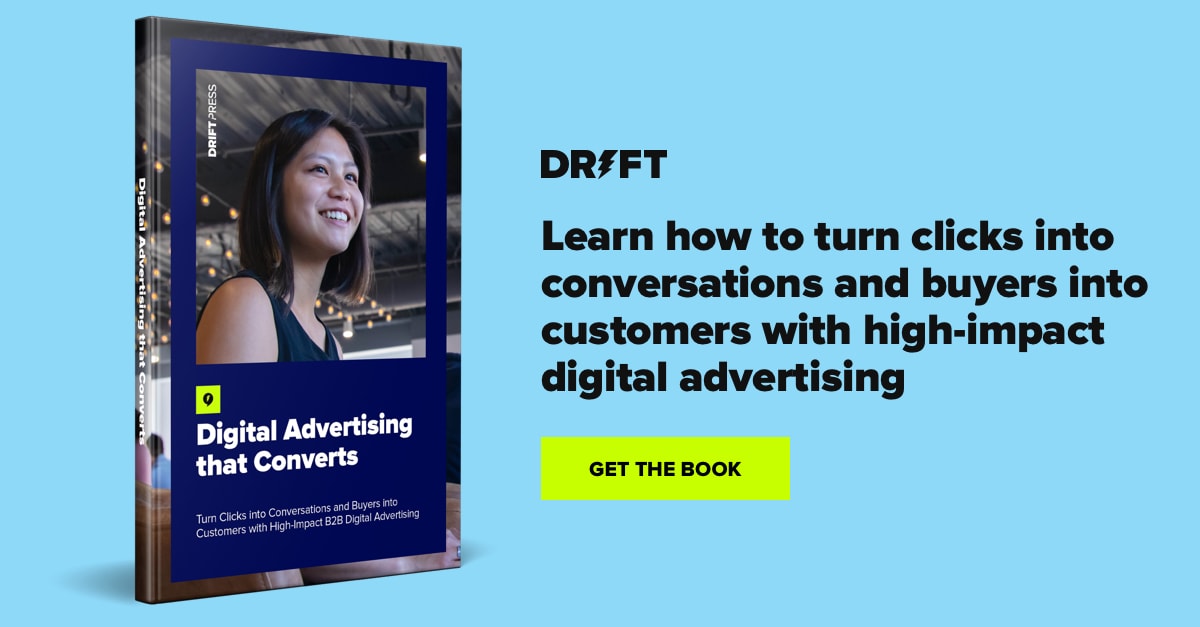Digital advertising now accounts for more than 60% of all ad spend worldwide. And that number goes up every year.
But B2B companies aren’t seeing many returns on ad spend. According to Unbounce’s Conversion Benchmark Report, landing pages for software as a service (SaaS) and business services convert only 3–4% of site visitors. That’s because most B2B companies capture prospects by gating content, and 81% of tech buyers don’t fill out the forms they encounter.
To truly make the most of your ads, you need to deliver a personalized and frictionless digital experience.
Unfortunately, B2B advertising is notoriously tricky. Your ads need to appeal to the wide range of personas involved in the buying process. Generic ads won’t work.
So, with all of this stacked up against you, how can you craft a B2B digital advertising strategy that will produce return on investment (ROI)?
In this post, I’ll walk you through how we do digital advertising at Drift.
Our team presented these strategies at the Content Marketing Institute’s Demand Generation Summit. If you want to watch the full presentation, click here. Otherwise, keep reading for all the insights💡
What Should Your B2B Digital Advertising Strategy Include?
As you develop your B2B advertising strategy, you’ll come up with a million questions: What message should I be sending? What channels should I be focusing on? How much budget should I divert to each campaign?
When you work off of an integrated marketing plan, it’s a lot easier to get those answers.
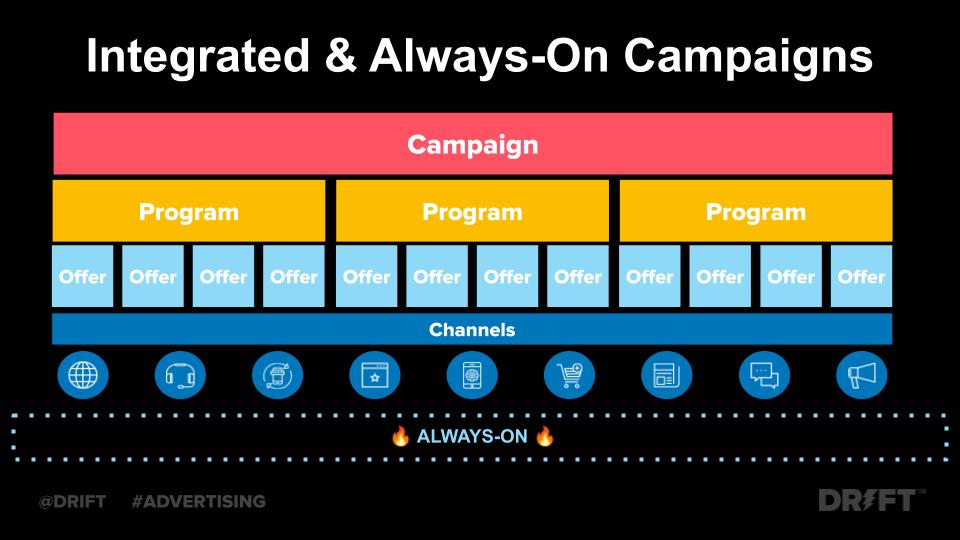
An integrated marketing campaign pools together talent and resources from across the entire marketing department to create a cohesive, multichannel experience for the buyer. Instead of each team running separate ads, an integrated campaign breaks down silos and gets everyone working together.
Your B2B ad strategy should start at the campaign level. Within each campaign, you’ll have programs, and those programs will include offers that need to be distributed across various channels.
Here’s an example 👇
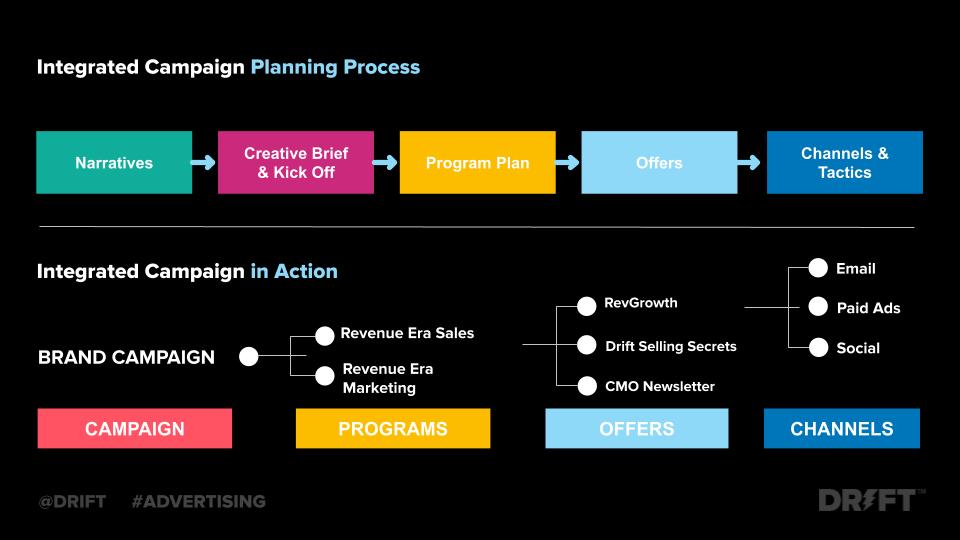
In our brand campaign, we developed two programs based on revenue era marketing and sales. We then designed three offers: an event, a report, and a newsletter. We advertised our event via email, paid ads, and social media channels (among others).
Because the planning process starts at the campaign level, the first thing that is set is your narrative. This then allows your marketing team to make decisions about the offers they will create while ensuring that everyone is aligned in their messaging.
Our Process for Creating a Successful B2B Digital Advertising Strategy
Now that you know what to say, it’s time to create your strategy. Integrated campaigns are complex, so as we run through these steps, things should get a lot clearer.
Step 1: Put Your Audience First
When running ads, the most important thing to remember is your audience. Your advertising strategy depends on who your offers are meant to target. Only then can you decide what to put in your copy or what channels to use.
The most important thing is starting with who.
Say you want to target marketing leaders at enterprise companies. You can tailor your ads to their position by promoting relevant content. For example, we might promote this case study about how Tenable generates 3x qualified pipeline with Drift, which includes quotes from their Senior Director of Global Marketing Operations and Technology. Or, we might advertise our CMO Secrets Revealed book.
In addition, you can consider how your campaigns map onto the buyer’s journey. This allows you to craft targeted ads based on the part of the customer journey each buyer is in.
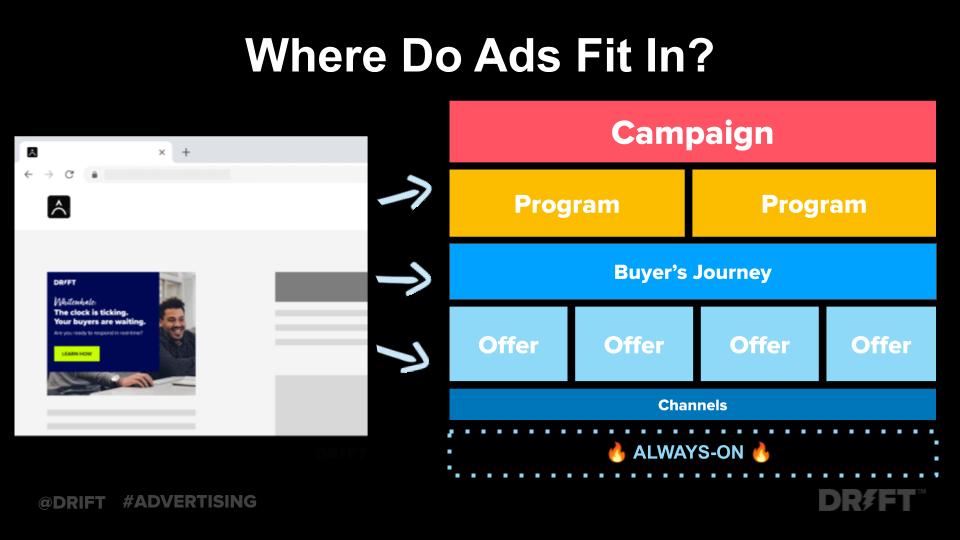
Over time, you’ll develop an advertising mix that consists of timely offers (aligned to your integrated campaign plans) and proven high-converting digital ad campaigns without end dates. Here at Drift, we call these top performers our “always on” campaigns. We know we can count on these campaigns to deliver month over month, and we use them as opportunities to A/B test and distill learnings on top-performing messaging, creative, and offers for various audiences.
Step 2: Create Compelling Offers
To drive down costs, you’ll want amazing conversion rates throughout every campaign. The single best way to optimize your conversion rates is to create better offers.
Ask yourself: What does my audience really want?
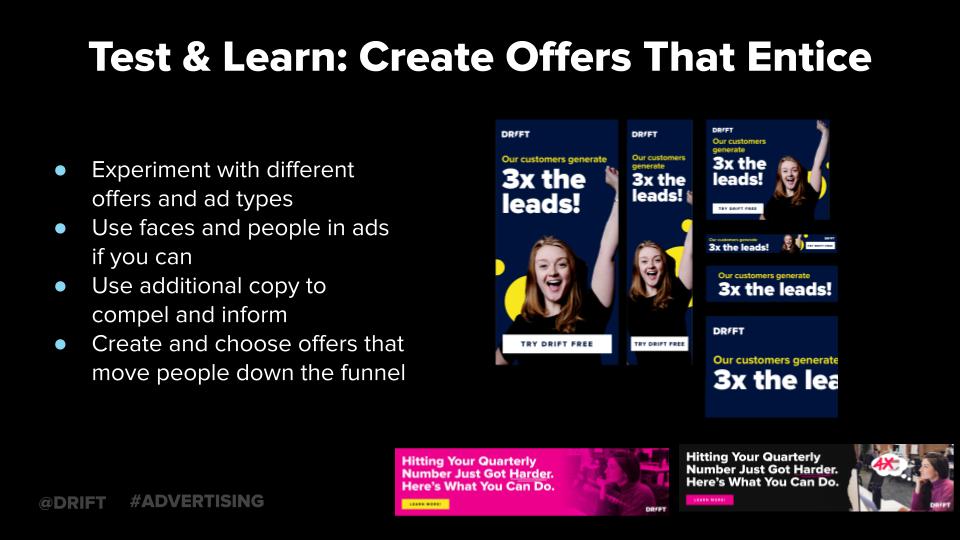
Don’t hide the good stuff. In many of our ads, we cut straight to the chase — like this one with the line: “Our customers generate 3x the leads!”
When promoting content, we use the same strategy. “Hitting your quarterly number just got harder. Here’s what you can do.” This copy is attention-grabbing because it addresses a pain point and promises a solution.
Your landing page needs to do a lot of the heavy lifting too. One of our key tips is to consider how your website appeals to the different types of buyers, or P.A.S.E. (practical, actionable, social, emotional). For example, to appeal to the social buyer, you’ll want to highlight some of your customers’ success stories on your page.
Lastly, you should be engaging with your buyers in real time with personalized messaging. And it should always be easy for your buyers to jump in with your sales team (more on that below).
Step 3: Nurture and Target Buyers with Digital Advertising & Conversational Marketing
We’re always asking ourselves how we can make it easier for our buyers to get in touch with sales.
When it comes to digital advertising, lead engagement shouldn’t be an afterthought.
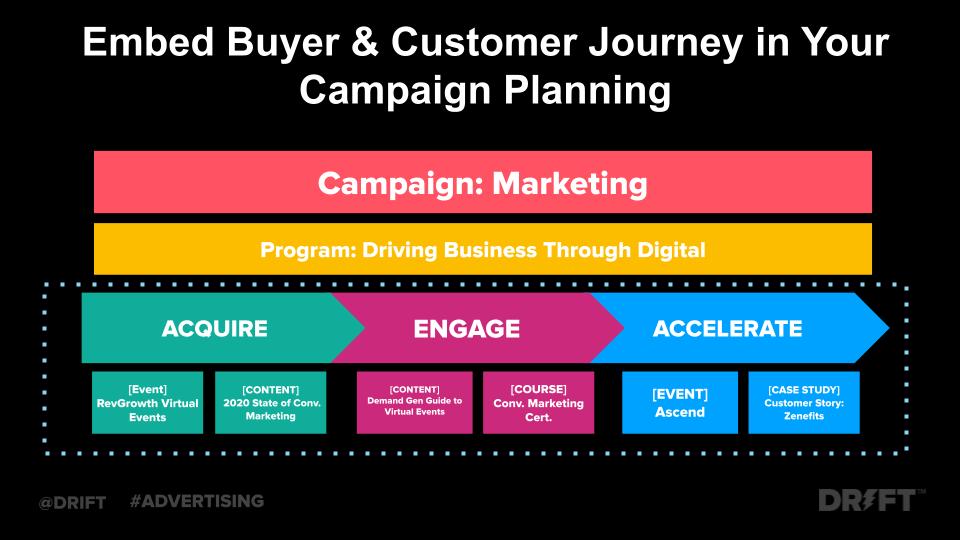
Your integrated marketing campaign should act as a roadmap for nurturing leads. This means that you should have offers geared towards buyers at every stage of the funnel so that you can visualize the entire buyer’s journey.
For sales, this roadmap is a toolkit for personalizing their engagement with prospects.
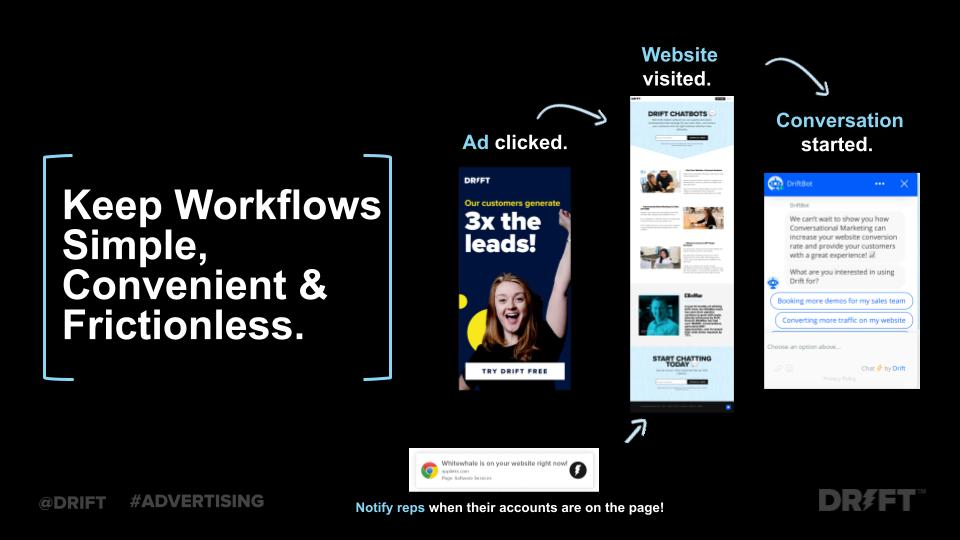
Ads often act as the first touchpoint in the buyer’s journey. It initiates the natural progression from the prospect’s interest to the start of a conversation.
When a buyer visits your website through an ad, you’re immediately keyed into their interests and pain points. So, when you strike up a conversation, you can personalize your messaging to address these topics from the get-go.
We do all this by using Drift’s Revenue Acceleration Platform. This allows us to:
- Personalize playbooks to create custom messaging
- Route reps into the conversation for real-time engagement
- Give buyers the chance to schedule time for a chat using the bot
We use Conversational Marketing to engage with all of our prospects, which reduces friction throughout the buying process and allows us to have genuine conversations with our buyers.
Step 4: Measure the Impact of Conversational Marketing on Your Campaigns & Conversions
Because we don’t have any forms on our website, we can’t measure our conversion rates based on form completion.
Instead, we measure conversions by the number of conversations generated. By doing this, we can find out which ads, offers, and programs are producing the most interactions with qualified leads.
There are a lot of metrics you can focus on, but what you choose to measure depends on what you want to know. So, you can measure anything from conversion rate per channel, cost-per-conversion, click-through rate, and so on.
We also want to know what happens after the conversation. Did that conversation contribute to pipeline?
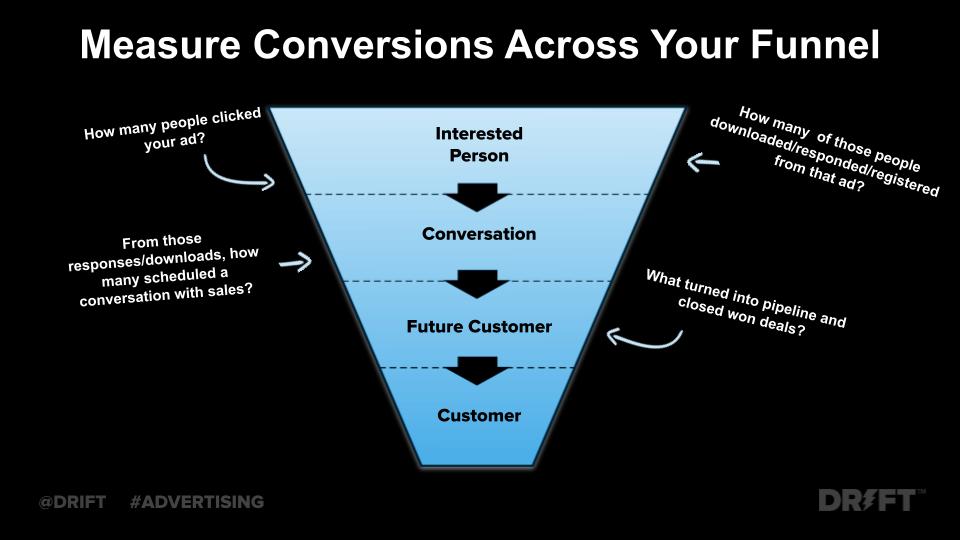
To run truly optimized and revenue-generating campaigns, you can’t stop at measuring page conversions. You need to measure your success all the way through the buyer cycle. This way, you can find out which ads and offers are bringing in real customers (and revenue) at each point of the funnel.
Step 5: Engage in Journey-Based Retargeting
Running targeted ads with compelling copy is good. But it might not be enough to convince your buyers to convert.
When it comes to B2B purchases, buyers are rarely ready to commit when they first visit your website. Usually, there is more than one stakeholder involved, and businesses have to weigh everyone’s concerns before deciding to purchase.
So, instead of running one targeted ad, you’ll need to evolve your ads as your buyer moves through the customer journey.
This is where journey-based retargeting comes in.
Journey-based retargeting acknowledges the time it takes to make that buying decision by keeping ads personal and relevant as a buyer (or account) gets more familiar with your value proposition and offerings. For example, if you want to re-engage a buyer who previously visited your pricing page, you can retarget them with higher-intent offers, such as customer case studies. You’ll want to keep making these adjustments as your buyer moves through the buyer’s journey.
You can do this by working with your marketing ops team to build out dynamic audience segments. This way, your list of contacts will automatically update as your prospect moves further along the funnel, making it easier to put out the right ads at the right time.
You can also do this at the account level. For example, if your sales team has a strong champion at a target account, you can use advertising to create a web of brand awareness and interest for other people on their team.
Retargeting ads are a surefire way to bring prospects back to your website. But with journey-based retargeting, you can make sure that you’re continually engaging with your prospects and you can keep the conversation going.
Step 6: Continually Revise Your Ads and Campaigns
When things aren’t working how you want them to, go back to your ads and campaigns. Is your ad copy as enticing as it should be? Do they motivate the buyer by displaying the scarcity of the product, offering a bargain, or appealing to their need to complete a task?
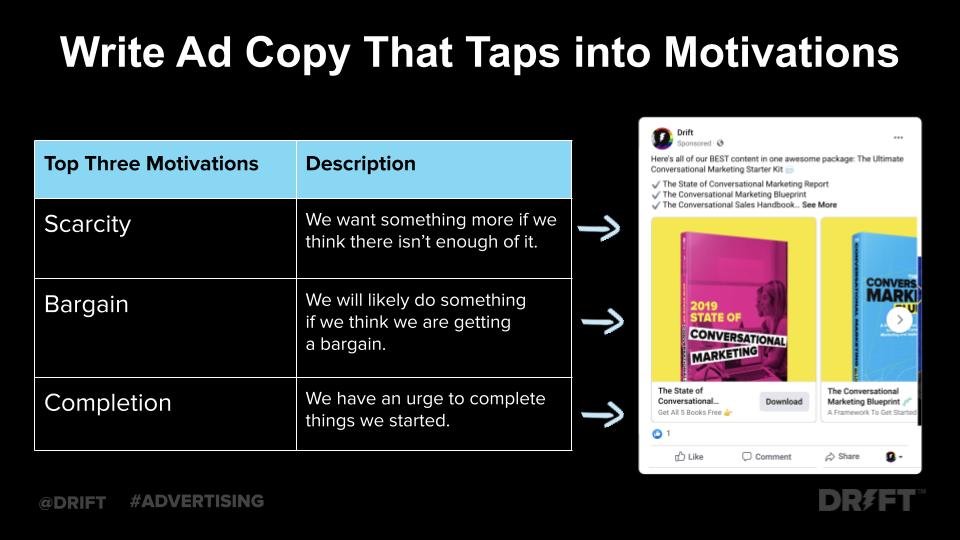
You might also go back to the drawing board with your campaigns. Maybe it doesn’t accurately map onto the buyer’s journey or help people progress through the funnel.
If no amount of copy tweaking works, interview your customers and listen in on sales calls to gain insights on how to make more impactful campaigns and offers.
Key Takeaways
Creating a B2B digital advertising strategy is complicated. But when you use integrated marketing campaigns, you can design effective ad campaigns that align your messaging across the entire marketing team.
From there, you can use the tips I’ve laid out here to develop compelling and personalized B2B ads that are sure to convert faceless visitors into leads, and leads into customers.





